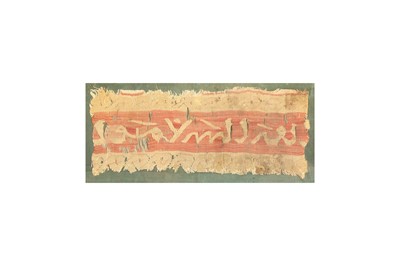28th Apr, 2023 11:00
Islamic Art - Property of a European Collector Part V
A CALLIGRAPHIC TIRAZ TEXTILE FRAGMENT
Fatimid Egypt, 10th - 11th century
A CALLIGRAPHIC TIRAZ TEXTILE FRAGMENT
Fatimid Egypt, 10th - 11th century
Of narrow rectangular shape, the panel made of white and red linen, slit-tapestry woven with a stylised Arabic naskh inscription in white on a red band, framed within two horizontal friezes of wavy strapwork in fine, sinuous red lines, laid on slate green silk, backed, taped and glazed, the panel 5.5cm x 13.5cm, 8.2cm x 19cm including the frame.
Provenance: Art Gallery À La Reine Margot, the oldest art gallery specialising in antiquities and archaeology in Paris, France, 1960;
Christie's London, 27 April 2004, lot 316 (one of two tiraz bands).
Inscription: " ... for the affairs ...(?)"
Epigraphy, and calligraphy as its extension, were two of the main forms igniting the interest in the arts of the Islamic lands among early 20th-century Western collectors. Often, the only fragments deemed worth preserving and collecting were the ones with inscriptions or figural motifs, leaving behind little to no evidence of the item’s original function, loom width, and exact location on the clothing. The panel in this lot, possibly a fragment from a court robe, is no exception.
In terms of decoration, the presence of an epigraphic Arabic naskh band points to a Fatimid attribution, but the wave pattern on the outer edges is clearly indebted to Egyptian pre-Islamic Coptic tapestries and their classical influences, showcasing the chronological evolution and complex cultural stratification of these textile fragments.
Dimensions: the panel 5.5cm x 13.5cm, 8.2cm x 19cm including the frame
Sold for £1,375
Includes Buyer's Premium
Do you have an item similar to the item above? If so please click the link below to request a free online valuation through our website.



